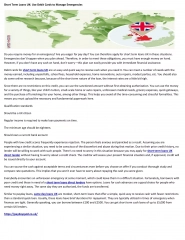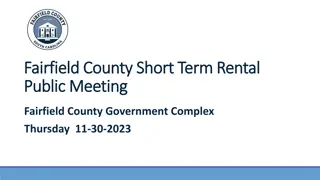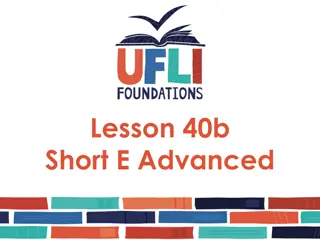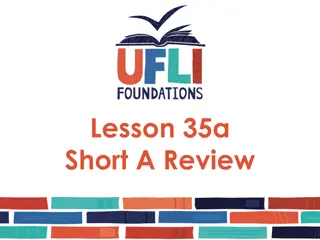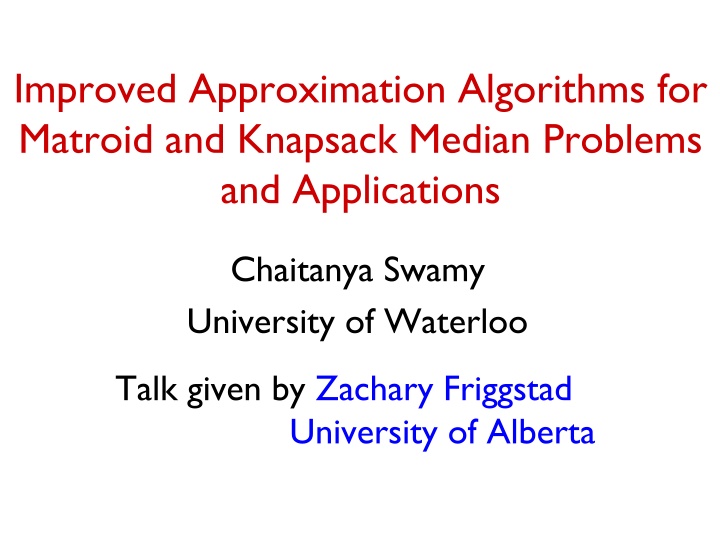
Improved Approximation Algorithms for Matroid Median Problems and Applications
"Discover how matroid median problems offer a unified framework for solving diverse facility location challenges efficiently, with improved bounds and rich modeling power. Explore the clean and natural generalization of various facility location scenarios, providing a comprehensive solution for seemingly disparate problems previously tackled separately."
Download Presentation

Please find below an Image/Link to download the presentation.
The content on the website is provided AS IS for your information and personal use only. It may not be sold, licensed, or shared on other websites without obtaining consent from the author. If you encounter any issues during the download, it is possible that the publisher has removed the file from their server.
You are allowed to download the files provided on this website for personal or commercial use, subject to the condition that they are used lawfully. All files are the property of their respective owners.
The content on the website is provided AS IS for your information and personal use only. It may not be sold, licensed, or shared on other websites without obtaining consent from the author.
E N D
Presentation Transcript
Improved Approximation Algorithms for Matroid and Knapsack Median Problems and Applications Chaitanya Swamy University of Waterloo Talk given by Zachary Friggstad University of Alberta
Matroid median client facility ? ,? ? ? ?,? , ? < ? ? ? ? s.t. ? {?} Sets in are called independent ? given by independent-set oracle 2 facilities 3 facilities ???: distance between points ? and ?. (???s form a metric.) Matroid ? = ( , ) on facility-set . Need to open facilities and assign clients to open facilities. Opening facility ? incurs facility opening cost ??. Assigning client ? to facility ? incurs assignment cost ???. Facilities opened must form an independent set in ?.
Matroid median client facility matroid ? open facility 2 facilities 3 facilities ???: distance between points ? and ?. (???s form a metric.) Matroid ? = ( , ) on facility-set . Need to open facilities and assign clients to open facilities. Facility opening costs {??}, client-assignment costs {???}. Facilities opened must form an independent set in ?. Minimize: facility opening costs + client assignment costs.
Matroid median is a clean, natural generalization of several facility location (FL) problems including: ?-median: any set of ? facilities is independent classical FL, clustering problem (CGTS02, JV01, CG99, AGKMMP04, LS13) red-blue median (HKK10): facilities are either red or blue; any facility-set with ?red red and ?blue blue facilities is independent motivated by content-distribution-network applications data placement problem (BR01, BRS08) abstracts data-management problem in distributed networks mobile facility location (DHMSOZ09, FS11, AFS13) motivated by supply-chain optimization (more reductions in the paper)
Matroid median is a clean, natural generalization of several facility location (FL) problems including: ?-median: any set of ? facilities is independent classical FL, clustering problem (CGTS02, JV01, CG99, AGKMMP04, LS13) red-blue median (HKK10): facilities are either red or blue; any facility-set with ?red red and ?blue blue facilities is independent motivated by content-distribution-network applications data placement problem (BR01, BRS08) abstracts data-management problem in distributed networks mobile facility location (DHMSOZ09, FS11, AFS13) motivated by supply-chain optimization (more reductions in the paper) Due to reductions in our paper Our improvement for matroid median yields improved bounds for these problems Matroid median thus provides a unified framework for studying these various, seemingly disparate, problems that model diverse settings and have previously been tackled separately Matroids have rich modeling power, so matroid median is likely to find further applications
Our contributions Devise an 8-approximation for matroid median via LP rounding Improves the 16-approx. by KKNSS (K+11) introduced the problem Algorithm has the stronger Lagrangian-multiplier-preserving property Technical contribution: significantly-simplified and better rounding algorithm and analysis for a natural LP proposed by K+11 High-level idea: use two applications of (clustering + integrality results of suitable ( matroid-intersection) polytopes) to round to integer solution CGTS02 clustering for ?-median can be leveraged to set up matroid- intersection problem and round to near-optimal half-integral solution Round half-integral solution by using simple FL clustering to set up matroid- intersection problem, use integrality of matroid-intersection polytope Gain dividends over K+11 by using integrality results to cleanly achieve various rounding steps. Explicitly moving to a half-integral solution and rounding it as above, avoids need for creating trees, stars etc. as in CGTS02 ?-median algorithm.
Our contributions Devise an 8-approximation for matroid median via LP rounding Improves the 16-approx. by KKNSS (K+11) introduced the problem Algorithm has the stronger Lagrangian-multiplier-preserving property Technical contribution: significantly-simplified and better rounding algorithm and analysis for a natural LP proposed by K+11 High-level idea: use two applications of (clustering + integrality results of suitable ( matroid-intersection) polytopes) to round to integer solution CGTS02 clustering for ?-median can be leveraged to set up matroid- intersection problem and round to near-optimal half-integral solution Round half-integral solution by using simple FL clustering to set up matroid- intersection problem, use integrality of matroid-intersection polytope (Independently, Charikar-Li obtained a 9-approximation for matroid median.)
Our contributions (contd.) Obtain insights into approximability of various extensions 24-approx. for matroid median with penalties: Clients may be left unassigned incurring a penalty for each unassigned client Vast improvement over the 360-approximation in K+11 No approximation possible for matroid-intersection median: Two matroids on facility-set, open-facility set must be independent in both Intuition: subroutine needed to round to half-integral or integral solution amounts to finding a min-cost common independent set of 3 matroids (as opposed to matroid intersection earlier) NP-hard But, obtain 8-approx. for 2 special cases of matroid-intersection median that capture some interesting FL problems: a) two-matroid median, b) laminarity-constrained matroid median Show that matroid-median + two-matroid median capture various FL problems data-placement problem, mobile FL, ?-median forest, obtain improved 8-approx. for all these
Our contributions (contd.) Adapt techniques to give a (32 + ?)-approximation for knapsack median (slightly improves 34-approx. in CL12) Knapsack constraint: (total weight of open facilities ?), replaces matroid-independence constraint Introduced by HKK10; Kumar12 gave first ?(1)-approximation
LP for matroid median ?? : 1 if facility ? is opened, 0 otherwise ??? : 1 if client ? is assigned to facility ?, 0 otherwise. ? : rank-function of matroid ? = ( , ), i.e., ? ? = maximum size of an independent subset of ? Minimize matroid polytope enforces that in an integer solution, open-facility set is in ????? + ?,??????? subject to ???? 1 ? ??? ?(?) ? 0, for each client ? for each facility ?, client ? for all ? ??? ?? ? 0 Can efficiently separate over matroid polytope can compute optimal LP solution (?,?) efficiently; ??? = cost of (?,?) For simplicity: assume that ??? {0,??} for all ?,?
Rounding (?,?): building intuition ??> 0 ?? = 0 ??? > 0 Easy case: suppose facility-sets ? {?:??? > 0} for different clients are either disjoint or identical (*)
Rounding (?,?): building intuition ??> 0 ?? = 0 ??? > 0 Easy case: suppose facility-sets ? {?:??? > 0} for different clients are either disjoint or identical Then, can easily round by solving a matroid-intersection problem Set up two matroids ?1,?2 on = ? ? where ?1= ? restricted to In ?2, a set ? is independent if ? ? 1 for all ? (*)
Rounding (?,?): building intuition ??> 0 ?? = 0 ??? > 0 = ? ? Easy case: suppose facility-sets ? {?:??? > 0} for different clients are either disjoint or identical ?1= ? restricted to , ?2= ( ,{?: ? ? 1 for all ?}) ? = point in intersection of matroid-polytope of ?1 and base-polytope of ?2 This polytope is integral, so can round ? to integer-point ? s.t.: ??? ??+ ? ? ???? ?? ? ? ?????+ ? ? ?????? (*) Linear function of ? cost of (?,?) Cost of integer solution given by ?
Rounding (?,?): overview ??> 0 ?? = 0 ??? > 0 Easy case: suppose facility-sets ? {?:??? > 0} for different clients are either disjoint or identical Plan: transform to (*) by clustering clients around centers so that if a client ? is clustered around a cluster-center ? then (i) ???= ?( ?? ???????) moving each non-center client ? to its cluster center gives instance satisfying (*) and of cost ??? can round as before; moving back clients incurs cost ?(???) (*) (ii) ?? ?? get ?(1)-approximation
Rounding (?,?): overview ??> 0 ?? = 0 ??? > 0 Plan: transform to (*) by clustering clients around centers so that if a client ? is clustered around a cluster-center ? then (i) ???= ?( ?? ???????) Use CGTS02 clustering: ensures (i), (ii), and (iii) if ?,? are centers then ??? > 4max{ ??, ?? }. (iii) for every center ?, every ? ? with ??? 2 ?? is private, i.e., not in any other ? private facilities of ? have fractional wt. 0.5 Exploit this structure to obtain half-integral solution, then cluster again to achieve (*) and round to integral solution (ii) ?? ?? But relaxes (*):
Rounding (?,?): more details 1. CGTS02 clustering: consider clients in ?? order to create centers ? s.t. ??? > 4max{ ??, ?? }for all ?,? ? ? ?, have some center ? = ? ? s.t. ?? ??, ??? 4 ??
Rounding (?,?): more details 1. CGTS02 clustering: consider clients in ?? order to create centers ? s.t. ??? > 4max{ ??, ?? }for all ?,? ? ? ?, have some center ? = ? ? s.t. ?? ??, ??? 4 ?? ?1 ? = ? ?1 = ? ?2 ?2 center non-center
Rounding (?,?): more details 1. CGTS02 clustering: consider clients in ?? order to create centers ? s.t. ??? > 4max{ ??, ?? }for all ?,? ? ? ?, have some center ? = ? ? s.t. ?? ??, ??? 4 ?? center non-center
Rounding (?,?): more details 1. CGTS02 clustering: ? = center-set ??? > 4max{ ??, ?? }for all ?,? ? ? ?, have some center ? = ? ? s.t. ?? ??, ??? 4 ?? Focus on instance where every non- center ? has been moved to ?(?) For ? ?, let ?? = # clients at ? s loc n. center non-center
Rounding (?,?): more details 1. CGTS02 clustering: ? = center-set ??? > 4max{ ??, ?? }for all ?,? ? ? ?, have some center ? = ? ? s.t. ?? ??, ??? 4 ?? Focus on instance where every non- center ? has been moved to ?(?) For ? ?, let ?? = # clients at ? s loc n. ??= 4 ??= 4 ??= 4 ??= 3 center non-center
Rounding (?,?): more details 1. CGTS02 clustering: ? = center-set ??? > 4max{ ??, ?? }for all ?,? ? ? ?, have some center ? = ? ? s.t. ?? ??, ??? 4 ?? Focus on instance where every non- center ? has been moved to ?(?) For ? ?, let ?? = # clients at ? s loc n. ??= {?:??? 2 ??} ? ?? 0.5 ? center ball ?? non-center
Rounding (?,?): more details 1. CGTS02 clustering: ? = center-set ??? > 4max{ ??, ?? }for all ?,? ? ? ?, have some center ? = ? ? s.t. ?? ??, ??? 4 ?? Focus on instance where every non- center ? has been moved to ?(?) For ? ?, let ?? = # clients at ? s loc n. ??= {?:??? 2 ??} ? ?? 0.5 ??= min {???: ? is not the center ??= {?:???< ??} ?? So ?? s are disjoint ?? ? ?:? is center nearest to ? (assume no ties) nearest to ?} center ball ?? non-center ball ??
Rounding (?,?): more details 1. CGTS02 clustering: ? = center-set ??? > 4max{ ??, ?? }for all ?,? ? ? ?, have some center ? = ? ? s.t. ?? ??, ??? 4 ?? Focus on instance where every non- center ? has been moved to ?(?) For ? ?, let ?? = # clients at ? s loc n. ??= {?:??? 2 ??} ? ?? 0.5 ??= min {???: ? is not the center ??= {?:???< ??} ?? So ?? s are disjoint ?? ? nearest to ?} center ball ?? non-center ball ??
Rounding (?,?): more details 1. CGTS02 clustering: ? = center-set ??? > 4max{ ??, ?? }for all ?,? ? ? ?, have some center ? = ? ? s.t. ?? ??, ??? 4 ?? For ? ?, let ?? = # clients at ? s loc n. ??= {?:??? 2 ??} ? ?? 0.5 ??= min {???: ? is not the center ??= {?:???< ??} ?? So ?? s are disjoint ?? nearest to ?} ? 2. Exploit structure to get half-integral solution. Let ? = ? ???. Let ? ? ?: ? ?? 0.5, ? ?? 1 ? ?, ? ? ? ? ? ? polytope of laminar matroid defined by { ??,??}? ? matroid ? polytope
Rounding (?,?): more details 1. CGTS02 clustering: ? = center-set ??? > 4max{ ??, ?? }for all ?,? ? ? ?, have some center ? = ? ? s.t. ?? ??, ??? 4 ?? For ? ?, let ?? = # clients at ? s loc n. ??= {?:??? 2 ??} ? ?? 0.5 ??= min {???: ? is not the center ??= {?:???< ??} ?? So ?? s are disjoint ?? nearest to ?} ? 2. Exploit structure to get half-integral solution. Let ? = ? ???. Let ? ? ?: ? ?? 0.5, ? ?? 1 ? ?, ? ? ? ? ? ? ? matroid-intersection polytope (with half-integral RHS) has half-integral extreme points
Rounding (?,?): more details 1. CGTS02 clustering: ? = center-set ??? > 4max{ ??, ?? }for all ?,? ? ? ?, have some center ? = ? ? s.t. ?? ??, ??? 4 ?? For ? ?, let ?? = # clients at ? s loc n. ??= {?:??? 2 ??} ? ?? 0.5 ??= min {???: ? is not the center ??= {?:???< ??} ?? So ?? s are disjoint half-integral extreme points ? ? ?? nearest to ?} ? 2. Exploit structure to get half-integral solution. Let ? = ? ???. Let ? ? ?: ? ?? 0.5, ? ?? 1 ? ?, ? ? ? ? ? ? For ? ?, if ??= ?? ? and ? ? is the center nearest to ? , then ??? 3?? for all ? ?? . Also ? ?? 1 ?(??) (for all pts. in ?). So ??(?) = ?? ? ???????+ 1 ? ?? Use this linear expression as proxy for assignment cost of ?? demand. 3?? 3 ??
Rounding (?,?): more details 1. CGTS02 clustering: ? = center-set ??? > 4max{ ??, ?? }for all ?,? ? ? ?, have some center ? = ? ? s.t. ?? ??, ??? 4 ?? For ? ?, let ?? = # clients at ? s loc n. ??= {?:??? 2 ??} ? ?? 0.5 ??= min {???: ? is not the center ??= {?:???< ??} ?? So ?? s are disjoint half-integral extreme points nearest to ?} 2. Exploit structure to get half-integral solution. Let ? = ? ???. Let ? ? ?: ? ?? 0.5, ? ?? 1 ? ?, ? ? ? ? ? ? Let ??(?) = ?? ? ???????+ 1 ? ?? Find (half-integral) ? = extreme-pt. of ? minimizing ? ?????+ ? ???? . 3?? for ? ?.
Rounding (?,?): more details 1. CGTS02 clustering: ? = center-set ??? > 4max{ ??, ?? }for all ?,? ? ? ?, have some center ? = ? ? s.t. ?? ??, ??? 4 ?? For ? ?, let ?? = # clients at ? s loc n. ??= {?:??? 2 ??} ? ?? 0.5 ??= min {???: ? is not the center ??= {?:???< ??} ?? So ?? s are disjoint nearest to ?} 2. Exploit structure to get half-integral solution ?. 3. Rounding ? is easy: half-integrality if ? is fractionally assigned to ? in ? then ???= ?(assignment cost of ? in ?) So standard FL clustering works, i.e., yields instance satisfying (*) 4. Round clustered instance as before.
Summary Devise a simple 8-approx. for matroid median (MMed). Techniques extend to yield: 8-approximation for two-matroid median (2MMed), laminarity constrained matroid median 24-approximation for matroid median with penalties Show that MMed and 2MMed capture diverse facility-location problems including data-placement problem, mobile facility location: get improved 8-approx. for these problems Devise (32 + ?)-approx. for knapsack median
Open questions ?(1) (true) approximation for matroid median with knapsack constraint ( FL with matroid-independence and knapsack constraint)? Lagrangian-multiplier-preserving property of our algorithm should be useful Combinatorial ?(1)-approximation for matroid median? No such algorithm is known even for the special cases of data-placement problem, mobile FL Improving approximation for MMed and knapsack-median? Can one exploit dependent-rounding technique in CL12 that was used for ?-median?


